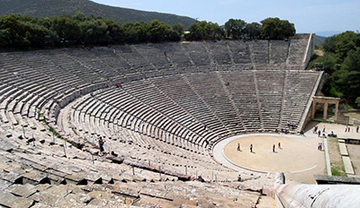Also on this page:
Greek Tragedy,
The Greek Theatre,
Ancient Greek Theatre,
Ancient Greek Theater,
Greek Chorus,
More Culture Topics
- Ancient Greek Religion
- Greece Movie
- Greek Architecture
- Greek Art
- Greek Bible
- Greek Columns
- Greek Costumes
- Greek Culture
- Greek Jewellery
- Greek Key
- Greek Masks
- Greek Music
- Greek New Testament
- Greek Orthodox
- Greek Philosophers
- Greek Pottery
- Greek Radio
- Greek Religion
- Greek Sculpture
- Greek Tattoos
- Greek Temples
- Greek Theater
- Greek Tv
More Topic Categories
Related Destinations
Greek Theater
 The Ancient Greek theatre started flourishing towards the end of the Archaic Era and fully developed during the Classical period, mainly in the city – state of Athens. Although it initially had a particularly religious and mystical character, it soon became a means of communicating thoughts and beliefs around social and political events of the time.
The Ancient Greek theatre started flourishing towards the end of the Archaic Era and fully developed during the Classical period, mainly in the city – state of Athens. Although it initially had a particularly religious and mystical character, it soon became a means of communicating thoughts and beliefs around social and political events of the time.The plays were staged on amphitheaters that consisted of three main parts, the Skene (stage), the Orchestra and the Coelon. The Skene, a rectangular building opposite the Coelon, was used as a dressing room, at least initially. It also had the aisles through which the actors went on stage. The orchestra was the main area at the centre of the theatre, on which the Greek chorus would act. It also included the Thymelis, an altar of Dionysus, as well as the Euripus, a drainage system around the orchestra. Finally, the Coelon was the amphitheatric area with seats for the audience and VIPs.
Most of the Ancient Greek tragedies and comedies, at least the surviving ones, were created in order to be staged at the Theatre of Dionysus in Athens. This theatre was probably constructed during the 6th century BC, and was expanded and renovated numerous times afterwards. Although the theatre was initially part of the yard of the Temple of Dionysus, more constructions were soon added; during the 5th century BC, Pericles asked the Odeon to be constructed east of the theatre, which was used as a waiting room for actors until they go on stage, as well as an area where the playwrights would publicly announce the titles of their dramas. However, the most important part of the theatre was the orchestra, the place where the chorus acted, consisting of 12 or 15 dancers. In contrast, there were only two or three actors; in fact, during the first plays, there was only one actor, whose role was simply to answer to the chorus’ questions and pleas.
The Ancient Greeks also developed sophisticated, for the time, machinery, to provide an extra touch to their theatrical plays. The “gods” would suddenly appear on stage through a trap door; other times, when the problem for the protagonist was unsurpassable, they would use a crane to make one of the “gods” appear as if flying and provide a solution. This was termed “god from the machine” or the more popular phrase “Deus ex machina” which became a synonym for someone who provides a way out of a seemingly unsolvable situation.
The best known ancient theatre is the one near Epidavros, and is considered the best structure in terms of acoustics and aesthetics. It was constructed between 340 – 330 BC by Polycletus the Younger, to provide a means of entertainment to the patients of Asclepiion, as well as a means of treatment; it was believed that going to the theatre was beneficial to psychological and physical health. It was made of limestone, which has the ability to absorb sound waves in the same way as the human body.
Three are the most important Ancient Greek tragedians, Aeschylus, Sophocles and Euripides. Although proliferate at their time, unfortunately only a few of their works survive today. Moreover, the most famous Ancient Greek comedian is Aristophanes, who had his own way of satirizing the events of political and social life through his works.
See Also:
 Athens Photos
Athens Photos
 Santorini Photos
Santorini Photos
 Crete Photos
Crete Photos
 Meteora Photos
Meteora Photos
 Corfu Photos
Corfu Photos



